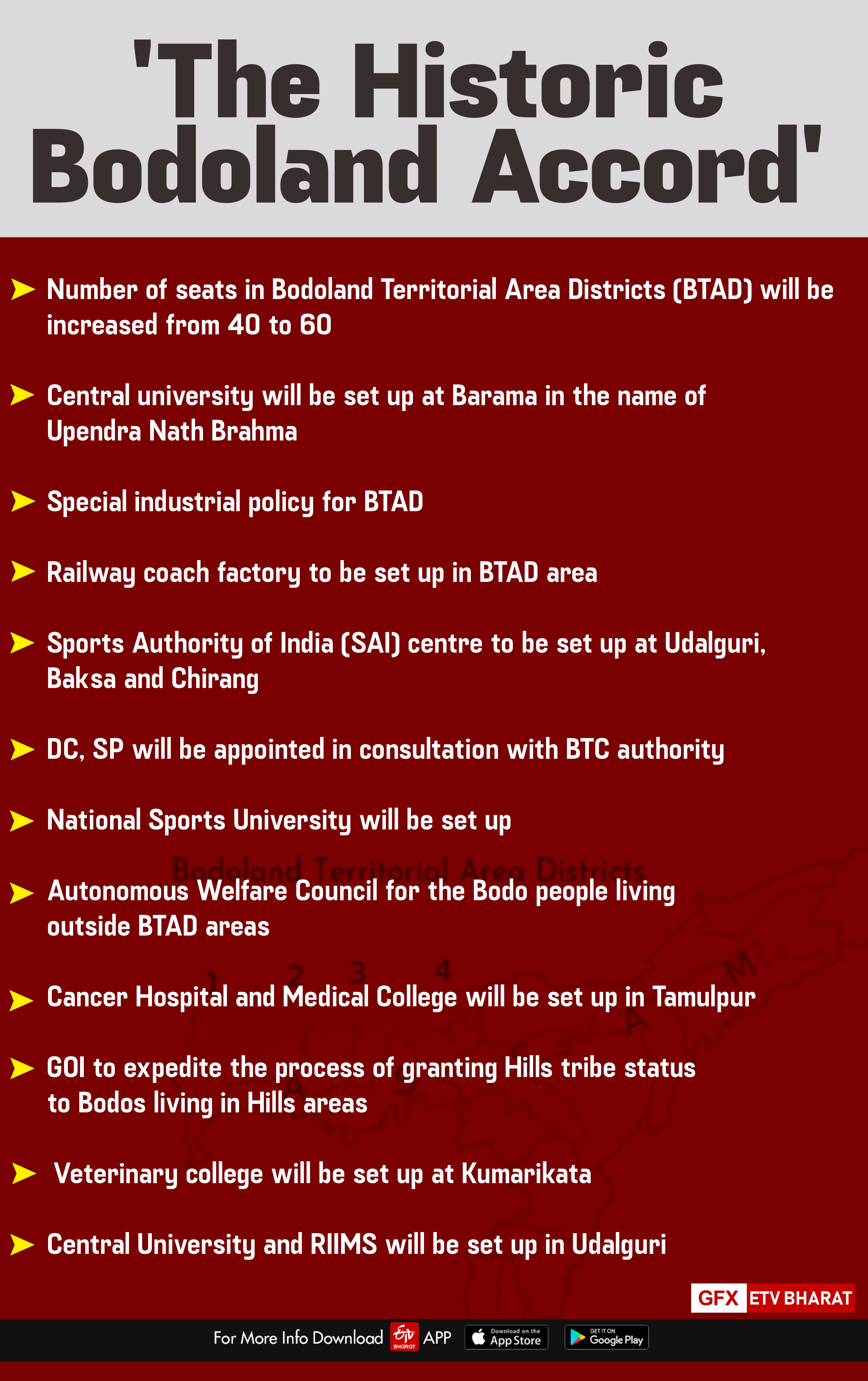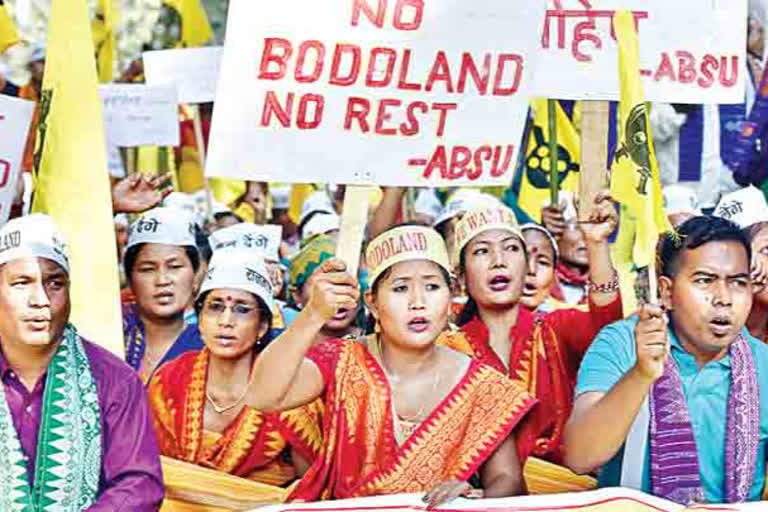Hyderabad: The tripartite accord signed in New Delhi gave birth to Bodoland Territorial Region (BTR). Cadres of all the four factions of the National Democratic Front of Bodoland (NSFB) will lay down arms on January 30.
Union Minister Amit Shah describing it as a 'historic accord', said: "A total of 1550 NDFB cadres along with 130 weapons will surrender in a ceremony on January 30."
He further added, " A special package of Rs 900 crore has been granted by the Centre for the overall development of the Bodoland areas. Bodo language will now be an associate official language with Devanagari script in Assam."
But, what is the Bodoland dispute and what are its demands. ETV Bharat in this article explains the Bodoland dispute:
On Monday, the government signed a tripartite agreement with representatives of all factions of the banned National Democratic Front of Bodoland (NDFB) at the Ministry of Home Affairs (MHA) in New Delhi.
Union Home Minister Amit Shah and Assam Chief Minister Sarbananda Sonowal were present during the signing of the agreement which was also attended by representatives of all factions of NDFB.

History of the formation of the Bodoland:
The emergence of a Bodo insurgency in the State has become another major problem.
The Bodos, a major tribe of plainsmen, are one of the earliest settlers in Assam. They have been demanding better social, political and economic conditions since independence. There has been a long history of tensions between the Bodos and the Assamese. The former feel that they have been neglected and exploited by the latter.
The All Bodo Students Union (ABSU) was formed in 1967 to represent the Bodo cause. In the early 1980s, the ABSU emerged as a potent force under the leadership of Upendranath Brahma.
A militant organisation, the Bodo Security Force (BSF) came into being in 1989 under the leadership of Ranjan Daimari.
The BSF later renamed the National Democratic Front of Bodoland (NDFB), resorted to terrorism in order to secure an ‘independent Bodo nation’ north of the river Brahmaputra.
A very large proportion of violent activities in the State, including killings, explosions, arson, and attacks on police stations, have been carried out by the NDFB. This is an organised and well-trained militant group with a strength of about 900.
It has established a ‘working arrangement’ with the NSCN – Isak-Muivah (NSCN-IM).
Another terrorist group, the Bodo Liberation Tiger Force (BLTF), headed by Prem Singh Brahma, has been fighting for a separate State of Bodoland within the Indian Union.
An accord was signed on February 20, 1993, between the Government of India, the Government of Assam and Bodo leaders, creating the Bodoland Autonomous Council (BAC) within Assam.
However, since Bodo villages are not contiguous, the demarcation of the jurisdiction of the BAC has remained a problem.
Both the NDFB and the BLTF have condemned the Bodo Accord, and have, since the mid-1990s, been engaged in a campaign of violence directed against other ethnic groups within ‘Bodo areas’.
Large scale attacks were carried out against Santhal tribals in May 1996, displacing tens of thousands of people.
The second wave of attacks in May 1998 displaced another couple of thousand Santhals. The Santhals and other non-Bodo communities have also begun to arm themselves and fight back
This has resulted in significant displacement of the Bodo population from areas where they are a minority.
Bodoland
Who are Bodos?
The Bodos, an ethnolinguistic group believed to be the earliest inhabitants of Assam, are one of the Indo-Mongoloid communities belonging to the Tibeto-Burman branch of the Sino-Tibetan family. At the zenith of their thriving civilisation, they ruled vast territories encompassing almost the entirety of northeast India, parts of Nepal, Bhutan, North Bengal and Bangladesh.
The Bodos are recognized as a plains tribe in the Sixth Schedule of the Indian Constitution.
Their Demand
A separate state(Bodoland)(within the Indian Union) be created by carving out some area of eight districts of the current State of Assam, namely Kokrajhar, Dhubri, Bongaigaon, Barpeta, Nalbari, Kamrup, Darang and Sonitpur districts.
Bodo Accord
In 2003, Bodo militants lay down the arms and want to join the mainstream and they signed an agreement with Government, known as “Bodo Accord”.
A BTC(Bodoland Territorial Council)created under the 6TH Schedule of the Constitution has been given legislative powers over 40 subjects.
BTAD(Bodoland Territorial Area District)created in 2003.
Problems in the Bodo Accord
The demand for a separate state is being justified on the basis of protecting the indigenous population of the BTAD which itself is contested.
The Bodos have portrayed themselves as the most rightful representatives of the BTAD. The BTC (Bodoland Territorial Council) is predominantly Bodo, as per the provisions of the Bodo Accord of 2003, but the BTAD areas do not have a homogenous demographic profile.
In fact, some villages of the BTAD are inhabited by a significantly larger number of non-Bodos than Bodos. Thus, the non-Bodo and Muslim communities feel under-represented at the BTC and have recorded their displeasure at the inequity in the distribution of resources and lack of administrative powers.
In addition is the territorial nature of the problem, which creates artificial boundaries in a naturally heterogeneous state and links ethnicity to land, leading to competing claims.
Two accords signed so far:
Third Bodo accord to be signed in the last 27 years when the violent movement for a separate Bodoland state claimed hundreds of lives, destruction of public and private properties in Assam.
First Bodo accord was signed with the All Bodo Students Union in 1993, leading to the creation of a Bodoland Autonomous Council with limited political powers
Second Bodo accord was signed in 2003 with the militant group Bodo Liberation Tigers (BLT), leading to the formation of a Bodoland Territorial Council (BTC) with four districts of Assam — Kokrajhar, Chirang, The demand for a separate state for the Bodos has been going on in Assam for about five decades
Bodo Accord 2020: Tripartite accord signed in New Delhi, all NDFB factions and ABSU part of the peace agreement.
Chronology of Bodo land conflict
The Bodos, the earliest settlers of Assam, are an ethnic and linguistic group which is a sub-group of the Bodo-Kachari family.
Although the Bodo agitation has a long history that dates back to the pre-Independence era, the movement gained momentum in the late 1980s, when calls were made for the bifurcation of the state of Assam. Some prominent armed separatist groups were founded during this period.
Bodos have advanced a number of reasons for wanting a separate state. They have called the territory they inhabit home for centuries, and are keen to protect their ethnic identity, way of life, and language. They also want better governance and development.
1929- Bodo leader Gurudev Kalicharan Brahma submits a memorandum to the Simon Commission asking for reservations in the Legislative assembly, and for a separate political entity for his people. His efforts go in vain.
The 1960s and 1970s- There are calls from Bodos and other tribes for a separate state of 'Udayachal' as immigrants are accused of illegally encroaching on Bodo-inhabited lands.
The late 1980s- Calls for a separate state for Bodos - Bodoland - and for Assam to be divided "50-50" are raised. Some, like Bodo leader and All Bodo Students Union (ABSU) president Upendranath Brahma, adopt a peaceful approach, but it is at this time that armed separatist groups like the Bodoland Liberation Tigers (BLT) and The National Democratic Front of Bodoland (of which NDFB(S) is a faction) are founded.
February 1993- The Bodoland Autonomous Council (BAC) is constituted after the Centre, the Assam government and the ABSU sign a tripartite agreement.
February 2003:
The Bodoland Territorial Council (BTC) is formed after the Centre, the Assam government and the BLT sign a tripartite agreement. The BLT is disbanded.
A Memorandum of Settlement (MoS) was signed by the central government, Government of Assam and the Bodo Liberation Tiger (BLT)on 10-2-2003.
The main clauses of the MoS inter alia includes setting up of Bodoland Territorial Council (BTC) in the State of Assam under the sixth Schedule to the Constitution of India, inclusion of Bodo language in the Eighth Schedule to the Constitution, revision of list of Scheduled Tribes for the State of Assam, setting up of Central Institute of Technology, additional development package of Rs.100 crore per annum for 5 years over and above the normal plan assistance to the State of Assam, rehabilitation of BLT cadres, etc.
The BTC will administer the Bodoland Territorial Area - an entity based on the idea of a 'state-within-a-state' and created by the reorganization of seven Assamese districts into four contiguous districts- Kokrajhar, Chirang, Udalguri, and Baksa.
Hagrama Mohilary, who currently heads the Bodo Territorial Council, was a leader in the now-defunct armed separatist group Bodo Liberation tigers.
2005- The National Democratic Front of Bodoland (NSFB) agrees to a ceasefire with the Assam government and the Centre. After the treaty is signed, the group splits into three factions. One of those factions, the NDFB (S), will continue to carry out violent attacks in the state.
2012- Ethnic riots involving Bengali-speaking Muslims and Bodos in Bodoland Territorial Area District kill 100 and render four lakh homeless. This isn't an isolated incident. Bloody clashes between Bodos and non-Bodos, especially Bengali-speaking Muslims, have been routinely reported in the region.
May 2014- Bodo terrorists kill more than 30 people in Kokrajhar and Baksa districts, allegedly believing that the victims hadn't voted for their candidates in the Lok Sabha elections held in April.
December 2014- Attacks by Bodo terrorists kill at least 81 people - including 76 Adivasis - and render 2 lakh homeless.
NDFB (S) is accused of carrying out both the May 2014 and December 2014 attacks in Assam, in which around 100 people were killed. After the December attacks, the Centre launches Operation All Out - a large-scale military operation involving the Army, the Air Force, Assam state police and paramilitary forces - with an aim to eliminate NDFB(S) completely.
August 2016- Terrorists kill 14 civilians at a market in Kokrajhar district. NDFB(S) is suspected to be behind the attack.
Also Read: Govt signs accord with NDFB, ABSU to resolve Bodo issue



